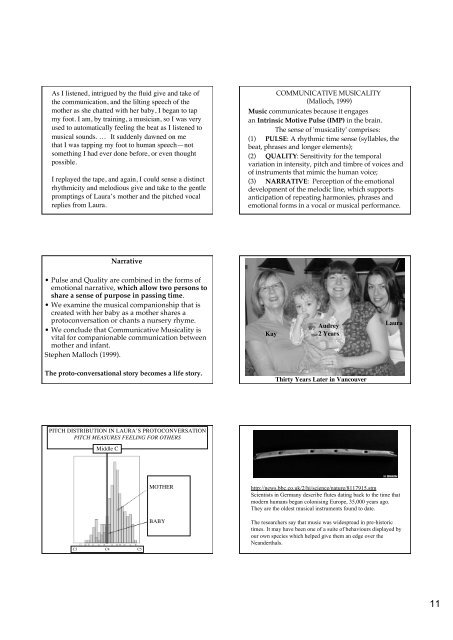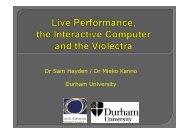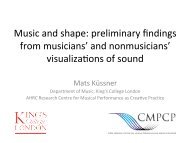Presentation: PPT file, 16Mb - AHRC Research Centre for Musical ...
Presentation: PPT file, 16Mb - AHRC Research Centre for Musical ...
Presentation: PPT file, 16Mb - AHRC Research Centre for Musical ...
Create successful ePaper yourself
Turn your PDF publications into a flip-book with our unique Google optimized e-Paper software.
As I listened, intrigued by the fluid give and take of<br />
the communication, and the lilting speech of the<br />
mother as she chatted with her baby, I began to tap<br />
my foot. I am, by training, a musician, so I was very<br />
used to automatically feeling the beat as I listened to<br />
musical sounds. … It suddenly dawned on me<br />
that I was tapping my foot to human speech—not<br />
something I had ever done be<strong>for</strong>e, or even thought<br />
possible.<br />
I replayed the tape, and again, I could sense a distinct<br />
rhythmicity and melodious give and take to the gentle<br />
promptings of Laura’s mother and the pitched vocal<br />
replies from Laura.<br />
Narrative<br />
• Pulse and Quality are combined in the <strong>for</strong>ms of<br />
emotional narrative, which allow two persons to<br />
share a sense of purpose in passing time.<br />
• We examine the musical companionship that is<br />
created with her baby as a mother shares a<br />
protoconversation or chants a nursery rhyme.<br />
• We conclude that Communicative <strong>Musical</strong>ity is<br />
vital <strong>for</strong> companionable communication between<br />
mother and infant.<br />
Stephen Malloch (1999).<br />
The proto-conversational story becomes a life story.<br />
PITCH DISTRIBUTION IN LAURA’S PROTOCONVERSATION<br />
PITCH MEASURES FEELING FOR OTHERS<br />
Middle C<br />
C3 C4 C5<br />
MOTHER<br />
BABY<br />
COMMUNICATIVE MUSICALITY<br />
(Malloch, 1999)<br />
Music communicates because it engages<br />
an Intrinsic Motive Pulse (IMP) in the brain.<br />
The sense of 'musicality' comprises:<br />
(1) PULSE: A rhythmic time sense (syllables, the<br />
beat, phrases and longer elements);<br />
(2) QUALITY: Sensitivity <strong>for</strong> the temporal<br />
variation in intensity, pitch and timbre of voices and<br />
of instruments that mimic the human voice;<br />
(3) NARRATIVE: Perception of the emotional<br />
development of the melodic line, which supports<br />
anticipation of repeating harmonies, phrases and<br />
emotional <strong>for</strong>ms in a vocal or musical per<strong>for</strong>mance.<br />
Kay<br />
Louise<br />
Audrey<br />
2 Years<br />
Thirty Years Later in Vancouver<br />
Laura<br />
http://news.bbc.co.uk/2/hi/science/nature/8117915.stm<br />
Scientists in Germany describe flutes dating back to the time that<br />
modern humans began colonising Europe, 35,000 years ago.<br />
They are the oldest musical instruments found to date.<br />
The researchers say that music was widespread in pre-historic<br />
times. It may have been one of a suite of behaviours displayed by<br />
our own species which helped give them an edge over the<br />
Neanderthals.<br />
11




